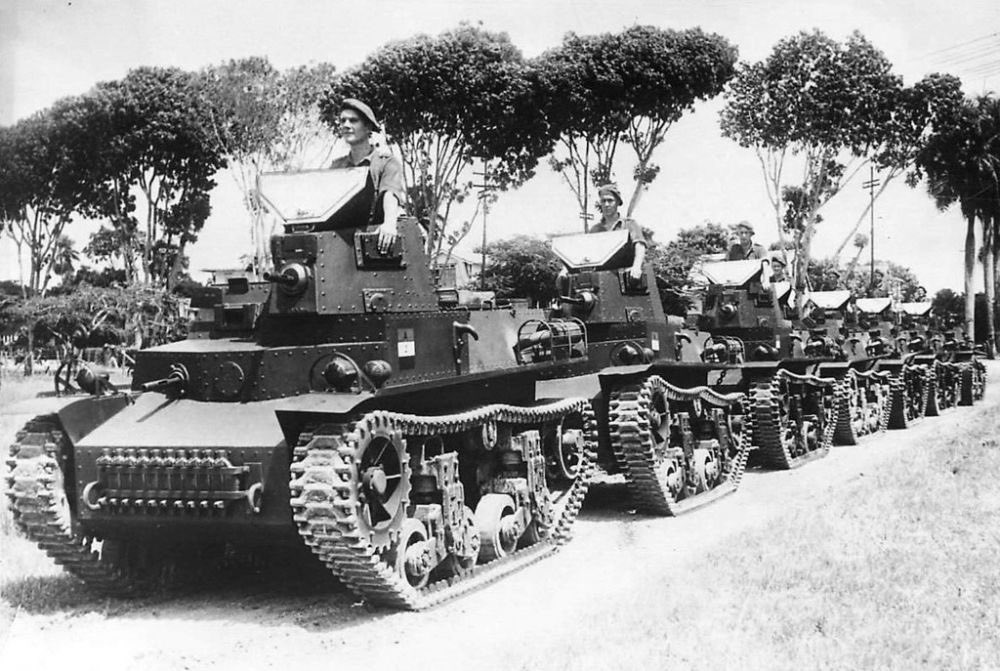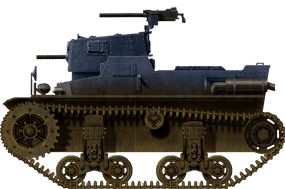Marmon-Herrington Company was specialized in commercial cars and trucks. It was based in Indiana but started to tackle the market of military trucks military trucks in 1933 and by 1936 even was interested when the US Marine Corps expressed a specification for a light tank transportable on its Navy Lighters. Marmon-Herrington at first proposed a modified tankette, the "CTL-3" in 1936, with 10 ordered in 1937. By 1938, a design for an armored car based on a commercial truck was asked by South Africa, the Marmon-Herrington Armoured Car and as the US rearmament expanded in 1939, Marmon-Herrington offered the improved CTL-3 in large production.
The USMC declined however, as the CTL-3 was proven unrlaiable, fragile, and inferior to the M2A4 and M3 Stuart, despite the fact the CTL-3 was still cheaper and lighter. 20 of a slightly improved version were offered as the CTL-6 in April 1940. However the British were at war in 1939 and suspended all exports to other nations. The Netherlands's possessions in the Caribbean and Dutch East Indies were vulnerable to attack from another power, Japan being the most threatening. The Royal Netherlands East Indies Army (KNIL) received 24 light tanks of a total 77 ordered before the war so Marmon-Herrington proposed its model and Dutch accepted on conditions to prepare modified specifications, seeing its armament and protection quite weak.
The Dutch, desperate for production placed an order for 200 of in December 1939 and paid them up quickly. Marmon-Herrington however never produced tanks in such quantity before and had to improvize ways to deliver more. Initial prospect for the KNIL was all delivered by December 1941, and went to make additional orders for the promising CTMS and MTLS. The first 20/24 vehicles arrived in Java however in early 1942, just as the Japanese were prepared for their campaign against the Dutch East Indies.

The 4TA in service on Java in early 1942, likely not long before their baptism of fire. Photo: SOURCE
But through dogged infantry support, the Battalion was soon overwhelmed and forced to retreat. The Japanese deployed notably fast moving cavalry units towing 47mm anti-tank guns and started to ambush and knowked down the Light Tank, with the Battalion was soon cut out and between the lack of ammunition and gasoline, they were abandoned, captured, destroyed, with the remaining 24 Marmons used in garrison position and later captured. Some would later see action in the Indonesian National Revolution by 1949.
The remaining tanks were diverted to Australia, and arrived by April-May 1942. But the Aussies were not impressed and they ended for the sake of standardization, in various training units for the 1st Australian Armoured Division, notably drivers. 11 were cannibalized, 138 declared obsolete in November 1943 and scrapped, recycled by Ford.
The USMC declined however, as the CTL-3 was proven unrlaiable, fragile, and inferior to the M2A4 and M3 Stuart, despite the fact the CTL-3 was still cheaper and lighter. 20 of a slightly improved version were offered as the CTL-6 in April 1940. However the British were at war in 1939 and suspended all exports to other nations. The Netherlands's possessions in the Caribbean and Dutch East Indies were vulnerable to attack from another power, Japan being the most threatening. The Royal Netherlands East Indies Army (KNIL) received 24 light tanks of a total 77 ordered before the war so Marmon-Herrington proposed its model and Dutch accepted on conditions to prepare modified specifications, seeing its armament and protection quite weak.
The CTLS-4TA
This improved model was based on the hull and chassis of the previous CTL-3 but the armor thickness weht from 12 to 25mm, and its standard .30 cal was replaced with a .50 heavy machine gun in its own brand new turret offset to right, plus another 0.3 cal. mounted in the hull, on the driver's side. They were designed oddly to operate in pairs. Variants thus were proposed, the 4TAC (right turret) and 4TAY (left one) as each was restricted to 270° of traverse because of the hull's shape in order to leave space for the driver as the compartment was quite small. It was powered by a 6-cylinder Hercules rated for 120bhp, and with its 8 tons translated as 30 mph.The Dutch, desperate for production placed an order for 200 of in December 1939 and paid them up quickly. Marmon-Herrington however never produced tanks in such quantity before and had to improvize ways to deliver more. Initial prospect for the KNIL was all delivered by December 1941, and went to make additional orders for the promising CTMS and MTLS. The first 20/24 vehicles arrived in Java however in early 1942, just as the Japanese were prepared for their campaign against the Dutch East Indies.

The 4TA in service on Java in early 1942, likely not long before their baptism of fire. Photo: SOURCE
Combat Records
After this first batch, a second was due to arrive in the next three months but the cargo carrying these was sunk underway to Java lieaving the KNIL with 24 ageing British Vickers Light Tanks and seven Marmons plus various armored cars to create the "Tank Battalion" responsible of the defence of Java at Bandung. The battle of Java started on the 28th of February and the batallion was sent to Buitenzorg, west Java, defended by poorly trained Indonesians. She were quickly routed. On March, 2, the Tank Battalion was ordered to counterattack at Soebang, and mauled down the Japanese infantry which retreated at first.But through dogged infantry support, the Battalion was soon overwhelmed and forced to retreat. The Japanese deployed notably fast moving cavalry units towing 47mm anti-tank guns and started to ambush and knowked down the Light Tank, with the Battalion was soon cut out and between the lack of ammunition and gasoline, they were abandoned, captured, destroyed, with the remaining 24 Marmons used in garrison position and later captured. Some would later see action in the Indonesian National Revolution by 1949.
The remaining tanks were diverted to Australia, and arrived by April-May 1942. But the Aussies were not impressed and they ended for the sake of standardization, in various training units for the 1st Australian Armoured Division, notably drivers. 11 were cannibalized, 138 declared obsolete in November 1943 and scrapped, recycled by Ford.

Marmon-Herrington CTLS-4TA by the author
The last CTLS
Meanwhile, another batch was asked for and delivered to the army in early 1942 and the evaluation team was stunned after brief trials by the quality of these cheap light tanks. They pressed the company to continue production of the 4TA for Lend-Lease, notably for Nationalist China as T14 and T16 depending on their turrets. However the delivery proved a logistical nightmare and since many M2A4s and M3 Stuarts already arrived, China rejected the tank, leaving 240 CTLS already paid for. So, instead of rotting in depots, the Japanese recent invasion of the Aleutians caused some fear that the woefully underquipped garrisons of Alaska would be at least provided with a tank to defend the Aleutian islands, allowing some Stuarts to go on other fronts. Still, they were unpopular wheh they arrived by late 1943, and soon declared obsolete.Marmon's CTMS was an improved tank with a crew of 3, 37mm gun and central turret. 31 were built but not completed as the Dutch East Indies fell, they were completed by order of the government to be donated to Central American countries around the Panama Canal. The MTLS was even larger, with a dual mounted 37mm guns, 4 crew and 38mm armour. The 19 built were in part shipped to Dutch Suriname and the rest ended at Aberdeen Proving Ground. It was found however very slow, with inadequate brakes and suspension so with immense reserves of M4 Sherman the story ended there. Marmon Herrington would work still on the M22 Locust Airborne tank in 1944 and is still in the business of truck parts today.

MTLS next and M22 Locust side by side, SOURCE
Specifications | |
| Dimensions | 3.51 x 2.10 x 2.10 m |
| Total weight, battle ready | 8 long tons |
| Crew | 2 |
| Propulsion | 6-cylinder Hercules 120bhp |
| Speed | 30 mph (48 km/h) |
| Range | 60 miles (96 km) |
| Armament | .50 Cal Browning M2 Heavy MG .30 Cal Browning M1919 Medium MG |
| Armor | From 25 to 12mm |
Links, Resources &Further Reading
Osprey Publishing, New Vanguard #186: US Marine Corps Tanks of World War IIPresidio Press, Stuart – A History of the Americn Light Tank, R.P. Hunicutt
Jane’s WW2 Tanks and Fighting Vehicles
Marmon Herrington Tanks in Australia
The Japanese Thrust, Australia in the war 1939-45
Imperial War Museum, IWM

WW2 Tanks




























WW2 tanks posters

All Tiger tanks liveries.

Panther liveries and variants

WW2 Armour - All tanks











Tanks aces and single tanks series

Find more there

Museums, Movies, Books & Games
The Tanks and Armor in pop culture
Tanks and armored vehicles in general are only really grasped when seen first person: The mass, the scale, it's all there. Explore also the way tanks were covered in the movie industry, in books and in video games.Movies:
Best tanks movie on warhistoryonline.com
On imdb.com
On bestsimilar.com/
miltours.com
liveabout.com/
watchmojo.com
Video Games:
pcgamesn.com
historyhit.com
levvvel.com
vg247.com/best-tank-games
mmobomb.com/
alienwarearena.com

